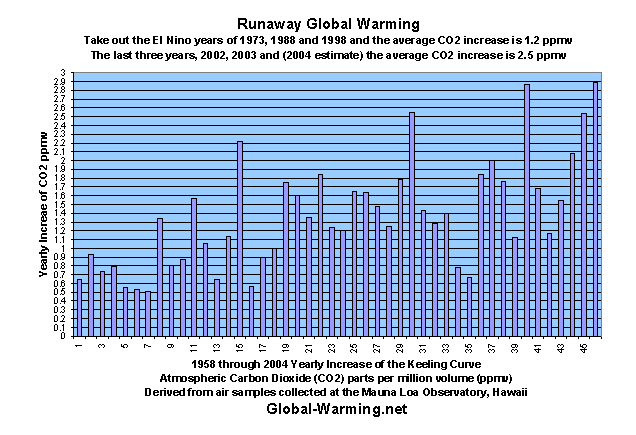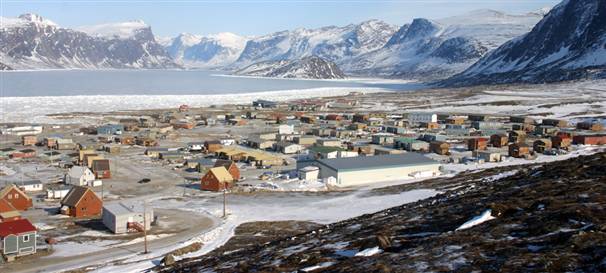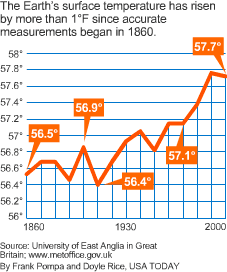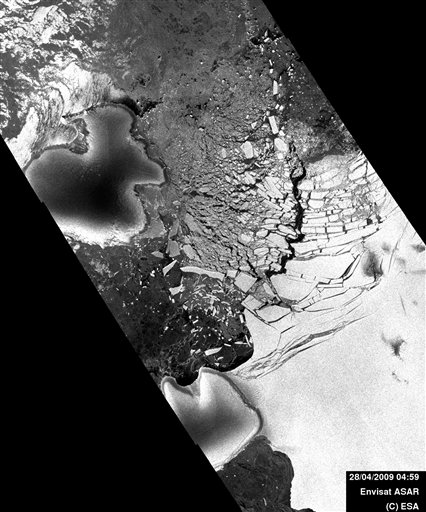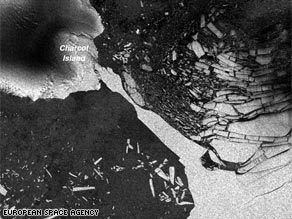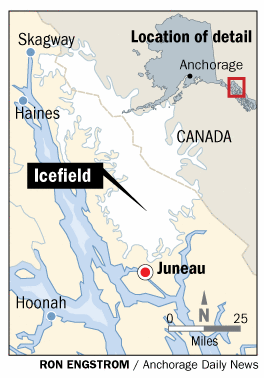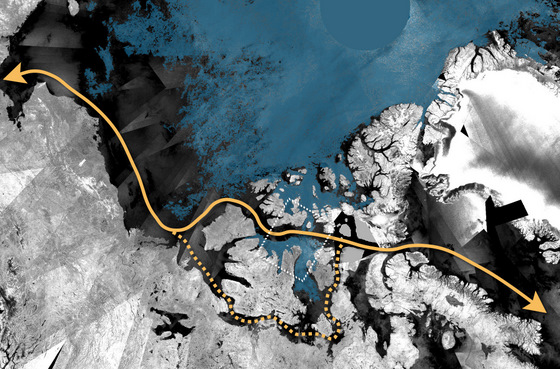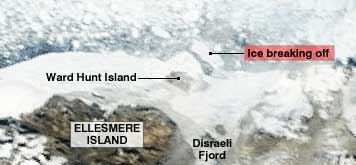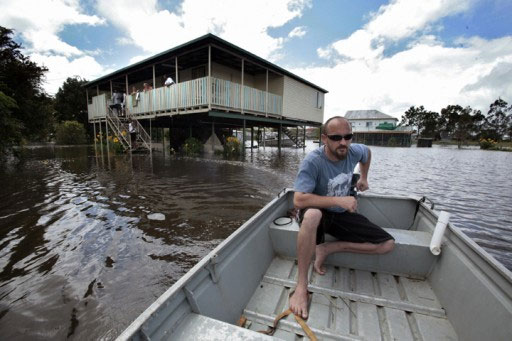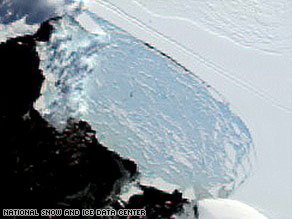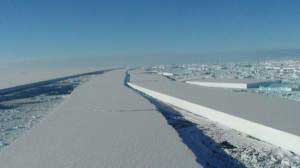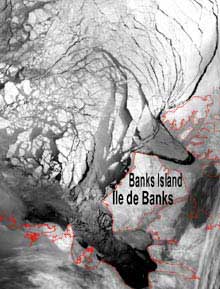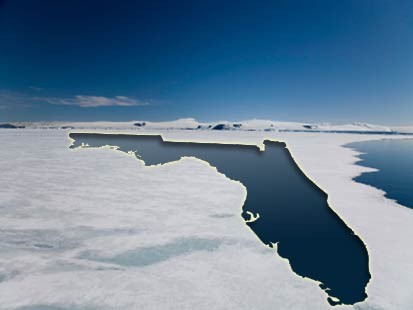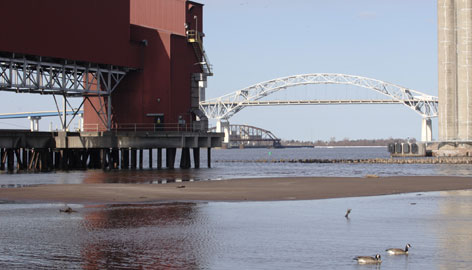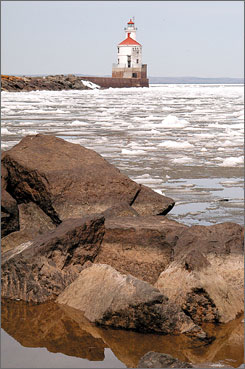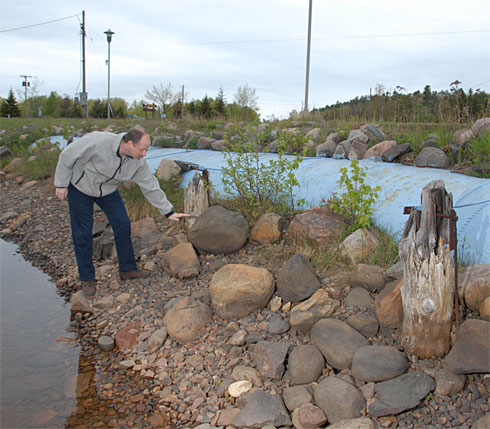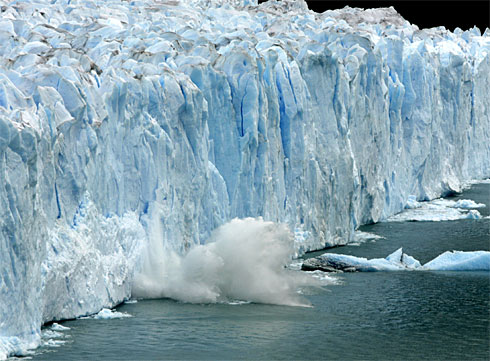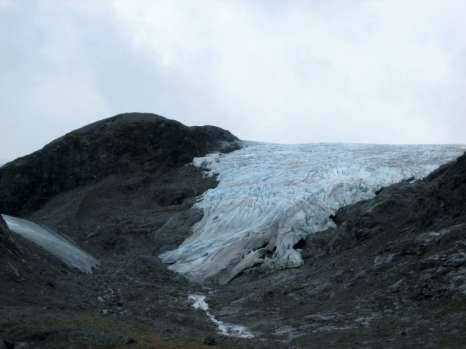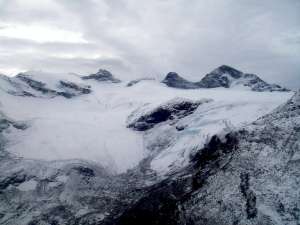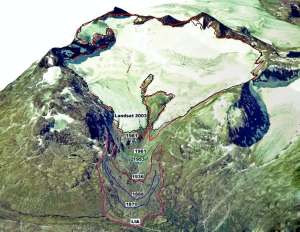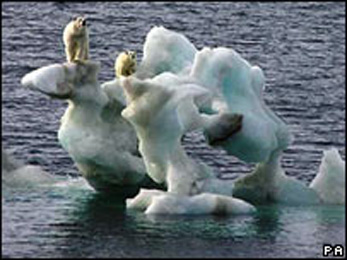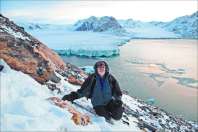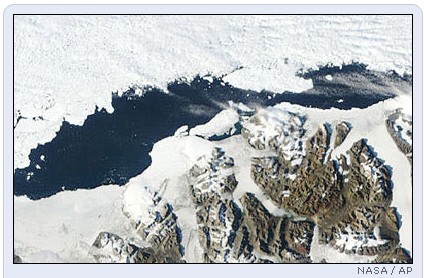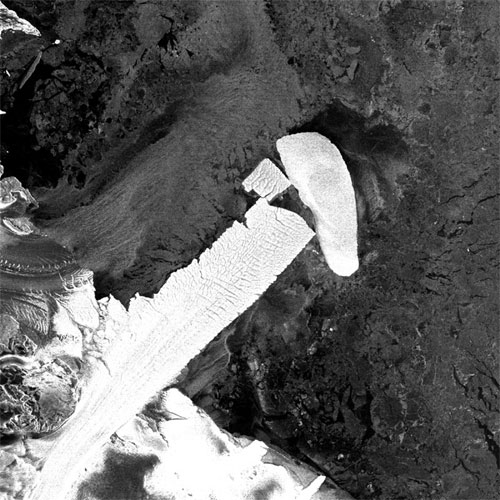Scientists Confirm Unexpected
Gulf Stream Slowing
09-May-2005
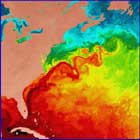
Gulf Stream |
Scientists from Cambridge University have confirmed that the Gulf Stream
is weakening, and this is likely to bring much colder temperatures to
Europe within a few years. The weakening is significant: the Gulf Stream
is flowing at a quarter of the strength that was present five years ago.
This is happening because gigantic chimneys of cold water that were
sinking from the surface to the sea bed off Greenland have disappeared.
These chimneys are the key engine of world climate as we know it today,
and their disappearance signals the beginning of a great catastrophe.
There will be a special report about this important story on this week's
Dreamland!
This is the first research to show unequivocal evidence of the
phenomenon, which was originally predicted in the Coming Global
Superstorm, published in 1999.
In Superstorm and in the film based on it, the Day After Tomorrow,
the event unfolds over the course of a week. The Cambridge scientists
are predicting now that there will be clear water at the North Pole as
early as 2020, and that temperatures in Britain are likely to drop by
5-8 degrees Celsius, from an average of 22 at present to 14 to 17 in the
future. An average as low as 17 (62 Fahrenheit) will mean that the
summer growing season will be catastrophically curtailed in Europe,
leading to huge declines in production from one of the world's primary
surplus production zones.
It will also mean that winters similar to those in Finland will
extend far south into France, and that there is a possibility that a
series of "no-melt" summers across the northern latitudes
could cause the reflectivity of the planet to increase to the point that
new glaciation will begin.
The weakening of the Gulf Stream is destabilizing currents worldwide,
and will lead to radical climate changes in other areas. The nature of
these changes is not known, and the current US administration has
blocked US environmental agencies from studying the phenomenon, so the
severity of its effect in this country is not under study. However, it
is likely that the eastern US and eastern Canada will experience climate
change as radical as that in Europe, as the Gulf Stream drops south. At
the least, food production and liveability in the eastern half of North
America will be severely challenged.
Scientists are currently assuming that the Gulf Stream will slow and
stop over a period of years, not suddenly, as predicted in Superstorm
and portrayed in the Day After Tomorrow.
However, there is ample evidence that sudden and extreme changes have
taken place worldwide in the past. Unknowncountry.com reported on this
phenomenon in December
of 2004 and earlier in November
of 2003.
There is a mechanism that changes a process of climate change that
seems to be unfolding over a period of years into a violent event that
takes just hours or days to develop, and then remains in a radically
changed condition. This happened 5,200 years ago, as has amply been
revealed in the fossil record.
Why it happened remains unknown, but it certainly had to do with the
very sort of spiking of temperatures that the world has experienced over
the past fifty years, and a reversal.
The changes that are taking place in the Gulf Stream are unstoppable.
They will unfold. How that will happen, and whether or not the process
will involve sudden and violent worldwide storms such as those that took
place 5,200 years ago remains unknown.
It is, however, essential that planning for the change begin at once.
At the least, the world faces dramatic economic upheavals and a decline
in food production at a time when both energy and food needs are at the
highest they have ever been in history.
So far, the only other media outlet that has picked up this story is
the Sunday Times of Great Britain, and they have not provided the true
perspective, or discussed the scale of the changes that are on their
way. For the Times story, click
here.
We need to concentrate on cleaning up our problems here on Earth so
future generations can inherit a world worth living in, before The
Day After Tomorrow arrives. Read the novella based on the hit movie!
|
| |
|
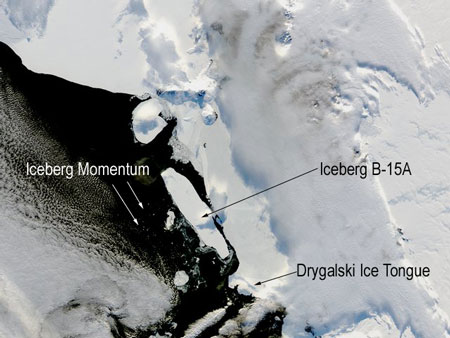
It is an event so large that the best seat in the house is in
space: a massive iceberg is on a collision course with a floating glacier
near the McMurdo Research Station in Antarctica. NASA satellites have
witnessed the 100-mile-long B-15A iceberg moving steadily towards the
Drygalski Ice Tongue. Though the iceberg's pace has slowed in recent days,
NASA scientists expect a collision to occur no later than January 15,
2005.
It's a clash of the titans, a radical and uncommon event," says
Robert Bindshadler, a researcher at NASA's Goddard Space Flight Center,
and if the two giant slabs of ice collide, we could see one of the best
demolition derbies on the planet. "Even a 'tap' from a giant can be
powerful. It will certainly be a blow far larger than anything else the
ice tongue has ever experienced," says Bindshadler.
When the iceberg and the ice tongue collide, the impact will likely
"dent their bumpers," says Bindshadler. The edges could crumple
and ice could pile or drift into the Ross Sea. But if the B-15A iceberg
picks up enough speed before the two collide, the results could be more
spectacular. The Drygalski Ice Tongue could break off.
The ice tongue is thick ice that grows out over the Ross Sea from a
land-based glacier on Antarctica's Scott Coast. "Ice tongues do break
off on occasion," says Bindshadler. "It would only take one thin
area on the ice tongue to make it break off." There's no guarantee
that the Drygalski Ice Tongue will break off, but "this is the
toughest blow it has ever had to deal with."
"That Ice tongue has no reason for staying intact" says Waleed
Abdalati, researcher with NASA's Goddard Space Flight Center, but
Bindshadler points out, it may not break up either. The results depend on
the movement of the B-15A iceberg.
The B-15A iceberg is a 3,000-square-kilometer (1,200-square-mile) behemoth
that has a history of causing problems. It is the largest fragment of a
much larger iceberg that broke away from the Ross Ice Shelf in March 2000.
Scientists believe that the enormous piece of ice broke away as part of a
long-term natural cycle (every 50-to-100 years, or so) in which the shelf,
which is roughly the size of Texas, sheds pieces much as human fingernails
grow and break off.
The berg initially drifted toward McMurdo Sound and grounded near Cape
Crozier on Ross Island. It has since broken into pieces, the largest of
which is B-15A.
This year, B-15A has trapped sea ice in McMurdo Sound. The currents that
normally break the ice into pieces and sweep it out into the Ross Sea have
not been able to clean out the Sound, so winter's thick ice remains
intact.
The build-up of ice presents significant problems for Antarctic residents.
Penguins must now swim great distances to reach open waters and food.
Adult penguins may not be able to make the trip and return with food for
their young. As a result, many chicks could starve, says Antarctica New
Zealand, the government organization that oversees New Zealand's Antarctic
research, in the Associated Press.
The National Science Foundation (NSF) officials said that the B-15A
iceberg and the frozen Sound will not interfere with supply ship access to
McMurdo Station, the U. S. logistics hub for much of the nation's research
activity in Antarctica. Forty miles of ice typically separate the pier at
McMurdo from the open sea, but this year the ice stretched 80 miles from
the station. So far, the extra ice has not been a problem. The U.S. Coast
Guard icebreaker Polar Star left Seattle, Washington, on Nov. 4 and docked
at McMurdo in early January after cutting a channel through the ice for
supply ships.
Ironically, a collision between the iceberg and the ice tongue could make
things easier for both penguins and ships. If the ice tongue collapses,
the way may be opened for sea ice to escape the Sound.
There is no guarantee that satellite will see a great demolition because
the berg's fate is unclear. The berg's future depends on unpredictable
winds, tides and other forces, but possibilities include colliding with
the floating Drygalski Ice Tongue, or continuing north, eventually
melting.
If the collision occurs as predicted, this could be an event that we
witness again and again. The tides that drive the iceberg's motion tend to
push it in circles. "If B-15A bangs the ice tongue once, it could
bang it again," says Bindshadler. With multiple daily views of the
Ross Sea, NASA satellites will be there to watch the show.
|
| |
| |
CLIMATE COLLAPSE
Growing Evidence of Scary Change
By David Stipp
http://www.fortune.com/fortune/technology/articles/0,15114,582593,00.html
Scientists used to think that major climate changes, like the onset of an
ice age, took thousands of years to unfold. Now they know such dramatic
transitions can occur in less than a decade. The probable trigger of abrupt
climate changes, at least in the Northern Hemisphere, is the shutdown of a huge
ocean current in the Atlantic Ocean. The current is driven by dense, salty water
that flows north from the tropics and sinks in the North Atlantic. If fresh
water is pumped into the northerly part of the current--which can occur as
global warming melts Arctic ice--its salinity drops, making it less dense. This
diminishing density can prevent the water from sinking in the North Atlantic,
stopping the current's flow. Much of Europe and the U.S. could become colder and
drier if that happened.
Many details of this big picture remain hazy, including whether recent global
warming threatens to shut down the Atlantic current. But over the past few
years, scientists have detected disquieting trends:
* In tandem with rising average temperatures across the globe, 3% to
4% of the Arctic ice cap has melted per decade since about 1970.
* Recently the Arctic's largest ice shelf broke up near Canada's Ellesmere
Island, releasing an ice-dammed freshwater lake into the ocean. (Scientists
believe that the similar melting of an Arctic ice dam 8,200 years ago triggered
an episode of abrupt climate change.)
* The North Atlantic's salinity has declined continuously for the past 40
years--the most dramatic oceanic change ever measured.
* The flow of cold, dense water through a North Atlantic channel near
Norway--part of the great ocean current that warms northern Europe --has dropped
by at least 20% since 1950, suggesting that the current is weakening.
Scientists still don't know whether a climate disaster is on the way. But taken
together, these changes appear strikingly similar to ones that preceded abrupt
climate shifts in the past. Many researchers now believe the salient question
about such change is not "Could it happen?" but "When?"
From the Feb. 9, 2004 Issue
Record retreat in Swiss glaciers in 2003 due to climate change: scientists
GENEVA (AFP) Jan 13, 2004
http://www.terradaily.com/2004/040113181427.hn018f6z.html
Switzerland's glaciers melted by a record amount during 2003 under the
onslaught of long-term climate change, a top Swiss science academy said Tuesday.
The retreat of the glaciers in the Swiss Alps reached up to 150 metres, with an
overall melting exceeding that observed in any year since measurements began in
the 19th century, according to the Swiss Academy of Natural Sciences. And the
shrinkage of the mountain ice was not the direct result of record hot summer
temperatures in Switzerland and Europe last year, it added. "The overall
view that emerges is of a clarity never seen before since annual measurements
started in 1880. None of the glaciers progressed or were stationary," the
academy in Bern said in a statement. "These observations should not be
associated directly with the extreme summer heat, the length of the glaciers
reacts with a delay to the change in climate," it added.
One of the academy's scientists explained that the overall length of the
glaciers reflected a warming of the climate over several years rather than
immediate shifts in temperature. More complex measurements of the thickness of
the ice cover -- which is affected by short-term heat -- on three glaciers also
showed melting last year exceeding the levels measured through the 1990s, said
Andreas Bauder. "The length change sums up all the climatic
influences," he told AFP.
"The glacier measurements are one of the best ways of documenting climate
change," Bauder added. The academy also cautioned that the advance of some
glaciers occasionally observed in recent years was caused by residues of old
snow, and was not due to the freezing of new rainfall during cold weather.
Overall, glaciers in the heart of Europe's biggest mountain range stopped
advancing about 50 years ago, Bauder pointed out. The Swiss length measurements
were based on regular data recorded on 96 Alpine glaciers.
Climate change has been blamed on global warming caused by the rise in air
pollution from greenhouse gases such as carbon dioxide.
Bauder said scientists were not able to predict longer term trends for the ice
floes but felt confident enough to forecast that the Swiss glaciers would again
shrink in 2004. "The glaciers will retreat, just on the signals we had in
the last couple of years," he observed.
TERRA.WIRE
http://www.newsday.com/news/nationworld/wire/sns-ap-earthshine,0,1655060,print.story?coll=sns-ap-nationworld-headlines
Earth Brightens After Years of Dimming
By RANDOLPH E. SCHMID
Associated Press Writer
May 27, 2004, 3:14 PM EDT
WASHINGTON -- Scientists studying earthshine -- the amount of light
reflected by the Earth -- say the planet appeared to dim from 1984 to 2001 and
then reversed its trend and brightened from 2001 to 2003.
The shift appears to have resulted from changes in the amount of clouds
covering the planet. More clouds reflect more light back into space, potentially
cooling the planet, while a dimmer planet with fewer clouds would be warmed by
the arriving sunlight.
That means the changes in brightness could signal climate change, though
it's too early to tell.
Steven Koonin, a California Institute of Technology physicist and
co-author of the paper, said that "at the moment, the cause of these
variations is not known, but they imply large shifts in the Earth's radiative
budget. Continuing observations ... will be necessary to learn their
implications for climate."
"This work is probably going to be used in arguments for and against
global warming. Our paper neither proves or disproves the carbon dioxide
effect," said Enric Palle, lead author of the report appearing in
Thursday's issue of the journal Science.
"Our results are only part of the story, since the Earth's surface
temperature is determined by a balance between sunlight that warms the planet
and heat radiated back into space, which cools the planet," said Palle, of
the Big Bear Solar Observatory in California, operated by the New Jersey
Institute of Technology.
Climate change "depends upon many factors in addition to (reflected
light), such as the amount of greenhouse gases present in the atmosphere. But
these new data emphasize that clouds must be properly accounted for and
illustrate that we still lack the detailed understanding of our climate system
necessary to model future changes with confidence."
The researchers used two sets of records to establish the amount of light
reflected from the Earth.
The records, which partly overlap, include measurements of cloud cover
taken by satellites and an analysis of earthshine, which was determined by
studying how much it illuminates the dark portion of the moon.
But the use of two separate types of measurements gave pause to James A.
Coakley Jr. of Oregon State University, who studies climate change and satellite
cloud data.
Observations of "sunlight reflected by the Earth are far from being
well understood. At this stage, it's too early to tell how useful such
observations might be as a measure of climate variability and climate
change," said Coakley, who was not part of the research team.
Philip R. Goode of the New Jersey institute, a co-author of the paper,
contended that the moon analysis is in fact quite accurate.
"Our method has the advantage of being very precise because the
bright lunar crescent serves as a standard against which to monitor earthshine,
and light reflected by large portions of Earth can be observed
simultaneously," said Goode.
Earthshine brightening the face of the moon, he noted, was first
described by Leonardo da Vinci.
Regular earthshine observations began in 1997, and the researchers
suggested that the changes they observed may be part of a natural variation.
Continuing the observations through an entire 11-year cycle of solar variability
will be important to better understand the changes, they said.
The research was funded by the National Aeronautics and Space
Administration.
Climate Change Rises on Global Agenda
May 23, 2004
By CHARLES J. HANLEY
FUNAFUTI, Tuvalu (AP) - The rising sea is eating at the shores of low-slung
Funafuti, a spit of coral and coconut palms in the remote Pacific. Unseen
fingers of ocean even reach beneath the sands, surfacing inland in startling
places, among nervous islanders. "It used to be puddles. Now it's like
lakes," said Hilia Vavae, local meteorologist.
Far to the north in the Marshall Islands, 1,250 miles away, trees are toppling
before aquamarine waves. Watching, perplexed, from the edge of a lagoon,
teenager Ankit Stephen asked a visitor, "Why is this happening?" Six
hundred miles west, on tiny Kosrae, Alokoa Talley pondered the same question.
Neighbors are moving their homes up the lush slopes, away from the encroaching
Pacific. "I don't know," the government worker said, "but I think
it's because of 'green' something." The "greenhouse effect,"
climate change, has languished on the world's agenda since the 1970s, a
seemingly distant threat. But year by year, inch by inch, it is rising to the
top - as ocean islets flood, glaciers retreat, Arctic permafrost melts, and
leading voices raise new alarms. "We may already be seeing - in the
increased incidence of drought, floods and extreme weather events that many
regions are experiencing - some of the devastation that lies ahead," U.N.
Secretary-General Kofi Annan said in March, when he urged all governments to
ratify the Kyoto Protocol to reduce the world's "greenhouse gas"
emissions.
That long-stalled 1997 accord is opposed in Washington, where U.S. government
and industry object that emission controls would handicap the U.S. economy. Now
only ratification by Russia can revive it, making this a critical year on the
political front in a long, difficult debate over what to do about climate
change.
On the scientific front, meanwhile, signs of global warming mount. Like the
glass of a greenhouse, carbon dioxide, methane, nitrous oxide and some other
gases in the atmosphere let sunlight in but tend to warm the Earth by trapping
heat it emits back toward space. That's scientific fact; the scientific puzzle
involves other factors that might lessen - or worsen - the warming and what it
does to the planet. Concentrations of carbon dioxide, a byproduct of fossil
fuels burned in everything from automobiles to electricity plants, reached
record levels in the atmosphere this past winter, a Hawaii observatory reported
in March.
Then, in April, other U.S. scientists reported NASA satellite readings showed
an average increase in the globe's land surface temperatures of 0.77 degrees
Fahrenheit between 1981 and 1998. This reinforced earlier findings, from ground
stations, that global temperatures rose 1 degree over the 20th century. These
rising curves, of greenhouse gas and global temperature, parallel the analysis
of the Intergovernmental Panel on Climate Change, a U.N.-organized network of
hundreds of climatologists and other scientists worldwide.
In a pivotal 2001 report, the IPCC listed as a key finding: "Most of
observed warming over last 50 years likely due to increases in greenhouse gas
concentrations due to human activities." If emissions are brought under
control too slowly, temperatures could rise an additional 10.4 degrees by the
year 2100, the IPCC said. Even with quick rollbacks in smokestack, tailpipe and
other emissions, temperatures could rise 2.5 degrees Fahrenheit by the end of
the century, the scientists said.
Warming is expected to be unevenly distributed and to change regional
climates in powerful ways, shifting climate zones hundreds of miles, possibly
making farmlands drier, deserts wetter; melting ice caps; intensifying storms;
spreading diseases to new areas; and raising ocean levels - by anywhere from 3.5
inches to almost 3 feet by 2100, depending on emission controls, the IPCC said.
The seas would rise because water expands as it warms, and because of the runoff
of ice melt from the continents. In fact, the oceans have expanded, rising an
average 1 to 2 millimeters a year - up to one inch every 12 years - during the
20th century, as measured by tide gauges. More recently, satellites show
"the rise has been highly accelerated," to 3 millimeters a year, said
Walter Munk of San Diego's Scripps Institution of Oceanography.
Pacific islanders aren't alone. Rising seas are a growing threat from Alaska,
where Eskimos are relocating an Arctic island village, to New Orleans and to
Shanghai, China - near-coastal cities already below sea level, sinking on their
own, and further endangered by expanding oceans. Prevailing winds, tidal
peculiarities and other factors can make sea levels vary from place to place.
Here at Funafuti, capital of a mini-nation midway between Hawaii and Australia,
the gauges have shown the sea rising 5 to 6 millimeters a year since 1993,
meteorologist Vavae said.
But some islands also are subsiding, sinking under their own weight. "In
many islands, I think the answer is that both are happening - subsidence and
rising levels," said University of Hawaii oceanographer Roger Lukas.
Similarly uncertain: What will a swelling ocean do to a Funafuti? One rule of
thumb, disputed among specialists, holds that each millimeter rise in sea level
can claim 1.5 meters - 5 feet - of shallow ocean beach. Some theorize, however,
that a moderately higher Pacific would "rearrange," but not
obliterate, an atoll like Funafuti - a ring of islands around a central lagoon.
Rearrangement would be bad enough for Lototele Malie, 75, whose pastel-blue
concrete house, with 15 adults and children inside, sits at the edge of
Funafuti's dwindling ocean beach.
"A month ago the tide came right here," the sarong-clad old man said,
pointing 3 feet away to the lip of his concrete-slab patio. "It's getting
dangerous," he said, with the thunder of waves as a backdrop. The Malies
and others along Funafuti's fringe have little room to maneuver. Just 300 yards
from their rear doors, the choppy waters of the 9-mile-wide lagoon are rising.
In between sit other salt-caked plywood or cinderblock houses, beside gaping
pits dug in the island's coral foundation long ago, by U.S. troops in World War
II. Those pits, filling now with seeping seawater, supplied the crushed material
for Funafuti's airport, where today some of Vavae's "lakes" have begun
to appear at peak tides. "People got especially worried when the runway
flooded. That's new," Margaret Bita, 45, told a visiting reporter after
Sunday church services.
The church and little airport lie on the broadest part - 600 yards across -
of slender, steamy, 7-mile-long Funafuti, home to about half the 11,000 people
of Tuvalu, an impoverished nation getting by on fees from foreign fishing
fleets, international aid and money sent home by Tuvaluan merchant seamen.
This main island narrows elsewhere to a mere 50 yards of sand, swaying palms and
roadway between lagoon and sea. Its elevation is seldom more than a few feet.
When February's "king" tides washed out a small causeway, children
swam to school. "I think it would be better if my kids were somewhere
else," said hospital worker Beia Fetau, 40, preparing to help with Sunday
school in shirt, tie and traditional male "sulu," or skirt.
As recently as the 1980s, Vavae said, the peak king tides came only in
January and February. Now, she said, they crash ashore from September to May.
But it's the quiet seepage from below that most alarms Tuvaluans. Because of
intruding saltwater, many have abandoned their gardens of deep-rooted "pulaka,"
a tuber crop grown in pits here for centuries. On the nearby islet of Vasafua,
the coconut trees are dying. Another small uninhabited island, Tepuka Savilivili,
has vanished beneath the waves. "It went under water in the cyclone in
1997," Vavae said.
Disentangling long-term climate change from short-term natural variability is a
challenge at the local level, especially in the Pacific, where the periodic
climatic phenomenon El Nino raises and lowers ocean levels, causes droughts and
stirs up severe storms. But people across the Pacific feel sure something
unusual is happening.
In Kiribati, another mini-state north of Tuvalu, they've also lost an islet
in the main atoll of Tarawa. On Majuro, the Marshalls' capital, the lagoon
outside Ankit Stephen's home has undercut dozens of towering coconut palms, as
islanders futilely try to stop the waves with piles of debris.
On Kosrae, a "high island" of volcanic peaks in the Federated States
of Micronesia, the people have always lived along a flat coastal strip, but some
are now dismantling their simple homes and heading for the hills, as recommended
by the government. "Nobody remembers such tides before. The sea is actually
moving inland," said Simpson Abraham, head of Kosrae's Resources
Development Authority. Some offshore islets have vanished, he said. Here in
Tuvalu, devoutly Christian since missionary days, many talk not of greenhouses,
but of Genesis, reminding each other of God's promise to Noah: As long as
rainbows cross the sky, there will be no more great floods. "God will
protect us," one woman churchgoer assured a visitor. Saufatu Sopoanga, as
Tuvalu's prime minister, must look into the future, not the Bible. He is talking
to New Zealand about a kind of 21st century Noah's ark - a standby plan for a
mass migration there. "In 50 or 100 years, the islands are expected to go
under water. What can we do?" Tuvalu's leader asked, on a day when a
tropical morning downpour soon gave way to a rainbow in a blue, very warm sky.
AUSTRALIA TOLD TO EXPECT REFUGEES FROM GLOBAL WARMING AFP
May 3, 2004
http://news.yahoo.com/news?tmpl=story&u=/afp/20040503/wl_asia_afp/australia_pacific_040503054336
SYDNEY - Environmental activists from Pacific nations threatened by rising sea
levels have called on Australia to recognise "environmental refugees"
who try to escape the effects of global warming.
The conservationists currently visiting Australia say climate change is raising
sea levels and increasing the frequency of events like cyclones
which will one day make some low-lying Pacific island nations uninhabitable.
Fiu Mataese Elisara-Laulu of Samoa said Australia, as the region's biggest
producer of the greenhouse gases which cause global warming, has a special
responsibility for the environmental damage caused.
"We have a genuine case for being affected as environmental refugees if
they don't do anything," he said on Australian Broadcasting Corporation
radio.
"But unfortunately Australia seems to be a very poor leader in the
Pacific," he said. "From our point of view, they want to assume
leadership but they don't want to take responsibility."
The conservative government of Prime Minister John Howard joined the United
States in 2002 in refusing to ratify a UN treaty on lowering the production of
greenhouse gases, saying the pact, known as the Kyoto Protocol was flawed.
Five weeks ago a group of Australian government researchers reported an alarming
increase in global greenhouse gas emissions since 2002, due almost entirely to
the burning of fossil fuels.
Greenhouse gases have been blamed for a steady warming of the earth's atmosphere
since the Industrial Revolution.
If left unchecked, global warming is projected to cause a significant rise in
sea levels over the next century through the melting of polar ice caps and
thermal expansion.
It is also blamed for an increase in extreme weather events like floods,
droughts and storms and damage to coral reefs and other sensitive ecosystems.
Elisara-Laulu was in Australia along with Siuila Toloa of Tuvalu's Island Care
group on a "climate justice tour" to lobby Australia to take a more
active role in tackling climate change.
The tour was sponsored by charity Oxfam, AID/WATCH and Friends of the Earth.
Iceberg Melt, Near South Georgia
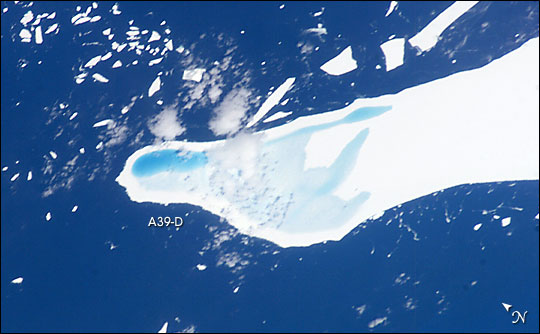
Astronauts on board the International Space Station took this detailed view
of melt water pooled on the surface of iceberg A-39D, an iceberg measuring 2 km
wide by 11 km long and currently drifting near South Georgia Island. The
different intensities of blue are interpreted as different water depths. From
the orientation of the iceberg, the deepest water (darkest blue) lies at the
westernmost end of the iceberg. The water pools have formed from snowmelt—late
January is the peak of summer in the Southern Hemisphere.
This iceberg was part of the original A-38
iceberg that calved from the Ronne Ice Shelf in October 1998. Originally the
ice was between 200 and 350 meters thick. This piece of that iceberg is now
probably about 150 meters thick, with around 15 m sticking up above the surface
of the water.
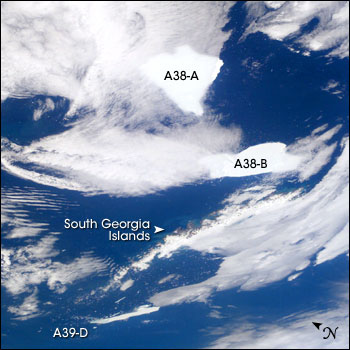
The top photograph was taken by astronauts looking south over the south
Atlantic Ocean from the International Space Station on January 22, 2004. Above,
an accompanying oblique view shows all three
large remnant pieces of A-38 close to South Georgia Island.
More melt water had formed on the surface of the iceberg when the Moderate
Resolution Imaging Spectroradiometer (MODIS) captured two additional images
on February
7 and February
9, 2004. The false-color
image from February 7 shows the entire top of the iceberg covered in a dark
blue pool of liquid water in contrast to the bright blue ice.
Both photographs were taken from the International Space Station using a Kodak
DCS760 digital camera and a 400-mm lens on January 6, 2004. ISS008-E-12555
was taken first, and ISS008-E-12564
was taken 2 minutes and 37 seconds later. Information provided by Ted Scambos,
National Snow and Ice Data Center; image provided by the Earth Observations
Laboratory, Johnson Space Center. The International
Space Station Program supports the laboratory to help astronauts take
pictures of Earth that will be of the greatest value to scientists and the
public, and to make those images freely available on the Internet. Additional
images taken by astronauts and cosmonauts can be viewed at the NASA/JSC Gateway
to Astronaut Photography of Earth.
4-18-04
Warming climate disrupts Alaskan natives' lives
Anyone who doubts the gravity of global warming should ask Alaska's Eskimo,
Indian and Aleut elders about the dramatic changes to their land and the animals
on which they depend.
Native leaders say salmon are increasingly susceptible to warm-water parasites
and suffer from lesions and strange behaviour. Salmon and moose meat have
developed odd tastes and the marrow in moose bones is weirdly runny, they say.
Arctic pack ice is disappearing, making food scarce for sea animals and causing
difficulties for the natives who hunt them. It is feared polar bears, to name
one species, may disappear from the northern hemisphere by mid-century.
As trees and bushes march north over what was once tundra, so do beavers, and
they are damming new rivers and lakes to the detriment of water quality and
possibly salmon eggs.
Still, to the frustration of Alaska natives, many politicians in the lower 48 US
states deny global warming is occurring or that a warmer climate could cause
problems.
"They obviously don't live in the Arctic," Patricia Cochran, the
executive director of the Alaska Native Science Commission, said.
The Anchorage-based commission, funded by the National Science Foundation, has
been gathering information for years on Alaska's thawing conditions.
The climate changes are disrupting traditional food gathering and cultures,
Larry Merculieff, an Aleut leader from the Pribilof Islands in the Bering Sea,
said.
Indigenous residents of the far north are finding it increasingly difficult to
explain the natural world to younger generations.
http://www.abc.net.au/news/newsitems/s1089723.htm
| Science |
| Sunday, March 28, 2004 |
2003
Likely Europe's Hottest in 500 Years
WASHINGTON (AP) - Last year's deadly summer in Europe probably was
the hottest on the continent in at least five centuries, according to
researchers who analyzed old records, soil cores and other evidence.
More than 19,000 people died.
Researchers at the University of Bern, Switzerland, collected and
analyzed temperature data from all over Europe, including such climate
measures as tree rings from 1500. They found that the climate has been
generally warming and last summer was the most torrid of all.
``When you consider Europe as a whole, it was by far the hottest,''
said Jurg Luterbacher, climatologist and the first author of a study
appearing this week in the journal Science.
Luterbacher said the study showed that European winters are also
warmer now. The average winter and annual temperatures during the three
decades from 1973 to 2002 were the warmest of the half millennium, he
said.
Some studies have linked rising average temperatures in North America
and elsewhere to global warming caused by the burning of fossil fuels,
but Luterbacher said his team did not attempt to make such a connection.
``We don't make any analysis of the human influence,'' he said. ``We
don't attempt to determine the cause. We only report what we find.''
Other climatologists, however, say the new study agrees with models
that have predicted a steady rise in global temperature as the result of
greenhouse gases released into the atmosphere from the burning of fossil
fuels and other sources.
Stephen Schneider, a climate expert at Stanford University and a
prominent advocate for the theory of human-caused global warming, said
the Luterbacher paper is consistent with what climate modelers have been
predicting for 20 years.
``The data is starting to line up showing that those projections were
correct,'' Schneider said. ``We warned the world that this was likely to
happen because we believed the theory, but couldn't actually prove it
was happening. Now the data is coming in.''
In the study, Luterbacher and his team analyzed the temperature
history of Europe starting in 1500 to the present. For the earliest part
of the half millennium, the figures are estimates based on proxy
measures, such as tree rings and soil cores. But after about 1750, he
said, instrumented readings became generally available throughout
Europe.
During the 500 years, there were trends both toward cool and toward
hot. The second hottest summer in the period was in 1757. That was
followed by a cooling trend that continued until early in the 20th
century. The summer of 1902, for instance, was the coolest of the entire
record.
Starting in 1977, the record shows ``an exceptionally strong,
unprecedented warming,'' the researchers report, with average
temperatures rising at the rate of about 0.36 degrees per decade.
Then came last summer.
``The summer of 2003 exceeded 1901 to 1995 European summer
temperatures by around 2 degrees C (3.6 degrees Fahrenheit),'' the study
said. ``Taking into account the uncertainties (in the study method), it
appears that the summer of 2003 was very likely warmer than any other
summer back to 1500.''
Record temperatures were recorded in most of the major cities of
Europe last summer, with many readings over 100 degrees. Authorities
have attributed thousands of deaths to the excess heat, making the heat
wave one of the deadliest weather phenomena in the past century.
In France, the toll was estimated at about 14,802 dead. About 2,000
more than normal died in August in England and Wales. On Aug. 11,
Britain's hottest day on record, there were 363 more deaths than average
and the temperature reading reached 101.3 in Brogdale in southeastern
England.
Altogether in Europe, based on official numbers collected by The
Associated Press, there were more than 19,000 excess deaths in the
summer months. France was hardest hit, but the average number of summer
deaths increased by 4,175 in Italy, 1,300 in Portugal and more than
1,000 in the Netherlands.
The intense heat also wilted crops, caused wildfires and continued a
centurylong trend of melting the continent's glaciers.
Luterbacher said some mountain glaciers have shrunk by 50 percent in
the past century in Europe, and some ice fields lost 10 percent of their
mass last summer alone.
In addition, he said, the long trend of warming temperatures is now
melting the high altitude permafrost - the soil that usually remains
frozen year-round - and that some buildings, bridges and roadways are
now threatened with unstable foundations.
And it may get worse, said Luterbacher. He said some studies forecast
that if the warming trend continues, Europe may have summers like 2003
every other year starting late in this century.
On the Net:
Science: www.sciencemag.org
|
Damage from Warming Becoming 'Irreversible,' Says New Report
Mon Mar 15, 2004 9:50 AM ET
Jim Lobe, OneWorld
US
WASHINGTON, D.C., Mar 15 (OneWorld) -- Ten years
after the ratification of a United Nations treaty on climate change, greenhouse gas emissions that lead to
global warming are still on the rise, signaling a "collective failure"
of the industrialized world, according to the Washington-based World Resources
Institute (WRI), a leading environmental think-tank.
"We are quickly moving to the point where the damage will be
irreversible," warned Dr. Jonathan Pershing, director of WRI's Climate,
Energy and Pollution Program. "In fact, the latest scientific reports
indicate that global warming is worsening. Unless we act now, the world will be
locked into temperatures that would cause irreversible harm."
WRI researchers estimate that greenhouse gas emissions such as carbon dioxide
rose 11 percent over the last decade, and will grow another 50 percent worldwide
by 2020. Under the 1997 Kyoto Protocol, the international agreement that sets
out specific targets to follow up on the treaty, 38 industrialized countries
were supposed to reduce their emissions by an average of seven percent below
1990 levels by 2012.
The administration of former President Bill Clinton signed the Kyoto
Protocol, but President Bush withdrew the U.S., which currently emits
about 25 percent of the world's greenhouse gases, from negotiations over Kyoto's
implementation.
Russia, which indicated initially that it intended to ratify the Protocol,
remains undecided. As a result the Protocol--which must be ratified by countries
whose greenhouse emissions totaled more than 55 percent of global emissions in
1990 in order to take effect--remains in limbo.
WRI decided to make a relatively rare public statement now, both because the
tenth anniversary of the UNFCCC's ratification will take place next weekend and
because of the growing pessimism surrounding the international community's
ability and will to deal with the problem.
The UN Framework Convention on Climate Change (UNFCCC), which called for
voluntary reductions in greenhouse emissions, was signed by, among others,
then-President George H.W. Bush, at the Earth Summit in Rio de Janeiro in 1992
and took formal effect March 21, 1994. Today, 188 countries are signatories.
The Kyoto Protocol grew out of the UNFCCC when it became clear that plans for
voluntary reductions would not meet the initial targets, and as climate and
atmospheric scientists on the Intergovernmental Panel on Climate Change have
become increasingly convinced that the rise in global temperatures of about one
degree Fahrenheit over the last century is due primarily to artificial
emissions, notably the combustion of fossil fuels, including coal, oil, and gas.
Studies over the past decade have shown that the warming trend continues.
"The five warmest years in recorded weather history have taken place over
the last six years," noted WRI's president, Jonathan Lash.
"The ten warmest years in recorded weather history have taken place
since 1987. Whether it's the retreat of glaciers, the melting of the permafrost
in Alaska, or the increase in severe weather events, the world is experiencing
what the global warming models predict," he said.
Europe, the main champion of the Kyoto Protocol, suffered its hottest year on
record last year. Some 15,000 people in France alone died due to heat stress in
combination with pollution, while European agriculture suffered an estimated
$12.5 billion in losses.
Britain's most influential scientist, Sir David King, recently excoriated the
Bush administration for withdrawing from the Protocol and ignoring the threat
posed by climate change. "In my view, climate change is the most severe
problem we are facing today," he wrote in Science magazine,
"more serious even than the threat of terrorism."
Even the Pentagon recently issued a warning that global warming, if it
takes place abruptly, could result in a catastrophic breakdown in international
security. Based on growing evidence that climate shifts in the past have taken
place with breathtaking speed, based on the freshening of sea water due to
accelerated melting of glaciers and the polar ice caps.
Given enough freshening, the Gulf Stream that currently warms the North
Atlantic would be shut off, triggering an abrupt decline in temperatures that
would bring about a new "Ice Age" in Europe, eastern Canada, and the
northeastern United States and similar disastrous changes in world weather
patterns elsewhere--all in a period as short as two to three years.
Wars over access to food, water, and energy would be likely to break out
between states, according to the report. "Disruption and conflict will be
endemic features of life," according to the report. "Once again,
warfare would define human life."
Even if climate change is more gradual, recent studies have argued that as
many as one million plant and animal species could be rendered extinct due to
the effects of global warming by 2050. A recent report by the world's largest
reinsurance company, Swiss Re, predicted that in 10 years the economic cost of
disasters like floods, frosts, and famines caused by global warming could reach
$150 billion annually.
"Accelerated development of a portfolio of technologies could stabilize
greenhouse gas concentrations, enhance global energy security, and eradicate
energy poverty," noted David Jhirad, WRI's vice president for research.
"We urgently need the political will and international cooperation to make
this happen."
Global warming has gone to the bogs
By Robert C. Cowen
Forget the melting glaciers. Global warming is revealing itself in subtler
ways. Think methane. Swedish bogs are releasing more methane as climate warms
and permafrost melts. Methane is a potent greenhouse gas with 25 times the
heat-trapping power of carbon dioxide (CO2). With more methane in the air,
climate warming could accelerate.
Meanwhile, just as global warming theory predicts, the atmosphere's highest
layers are getting colder and thinner. Contrary to expectations, high atmospheric
cooling is the way greenhouse gases, such as CO2 and methane, interact with
infrared (heat) radiation. At low altitudes, they absorb heat coming up from
below and radiate some back downward.
But where astronauts live, these gases release most of their heat out into
space, which cools the higher altitudes. The outer atmosphere contracts as
it cools, thinning out its density.
Satellites orbiting a few hundred miles out would feel less drag as the air
through which they travel becomes thinner.
That's how John Emmert and colleagues with the Naval Research Laboratory
in Washington found evidence that this long-expected global warming effect
is under way.
They report in the Journal of Geophysical Research that 30 years of tracking
data for 27 satellites and space junk show a steady decline in outer atmospheric
density.
That's good news for satellite owners who can use less rocket fuel to keep
their birds aloft. The news from Sweden is more troubling.
Bacteria in wetlands release methane as they break down organic matter. It's
the marsh gas that sometimes ignites to make spooky lights in the night.
This activity slows down when bogs freeze.
Northern peat bogs - especially in subarctic Eurasia - are major sources
of methane, which spreads throughout the world. Scientists have wondered
what will happen as permafrost continues to melt and bogs become even more
biologically active.
An international research team recently provided a window into that future.
The group, led by Torben Christensen and colleagues at Lund University's
GeoBiosphere Science Center in Sweden, studied 30 years of changes in Sweden's
Abisko region. Their results, published in Geophysical Research Letters,
show Sweden's sub-arctic bogs are losing permafrost rapidly. It's completely
gone in some areas. And Dr. Christensen says that, at the Stordalen site,
methane emission is up "at least 20 percent, but maybe as much as 60 percent,
from 1970 to 2000."
His team report warns that if its findings are typical of the northern subarctic,
global warming could accelerate as bogs thaw.
Laurence Smith at the University of California at Los Angeles and colleagues
with a joint Russian-American research team expressed a similar concern last
January in Nature.
Their studies of vast peat lands in Siberia show the bogs currently absorb
a lot of CO2 from the atmosphere while releasing methane. But this could
change. If global warming continues, the researchers warn that chemical and
biological activity in the bogs could break down organic matter that now
stores CO2, releasing a major new source of the gas back into the atmosphere.
The bottom line is that we have to pay attention to subtle effects. We're
not going to be drowned by melting glaciers, but we might be bitten by what's
sneaking up on us.
http://www.csmonitor.com/2004/0311/p17s01-sten.html
2003 Likely Europe's Hottest in 500 Years
|
|
By PAUL RECER, AP Science
Writer
WASHINGTON - Last year's deadly summer in Europe
probably was the hottest on the continent in at least five centuries, according
to researchers who analyzed old records, soil cores and other evidence. More
than 19,000 people died.
Researchers at the University of Bern, Switzerland, collected and analyzed
temperature data from all over Europe, including such climate measures as
tree rings from 1500. They found that the climate has been generally warming
and last summer was the most torrid of all.
"When you consider Europe as a whole, it was by far the hottest," said Jurg
Luterbacher, climatologist and the first author of a study appearing this
week in the journal Science.
Luterbacher said the study showed that European winters are also warmer now.
The average winter and annual temperatures during the three decades from
1973 to 2002 were the warmest of the half millennium, he said.
Some studies have linked rising average temperatures in North America and
elsewhere to global warming caused by the burning of fossil fuels, but
Luterbacher said his team did not attempt to make such a connection.
"We don't make any analysis of the human influence," he said. "We don't attempt
to determine the cause. We only report what we find."
Other climatologists, however, say the new study agrees with models that
have predicted a steady rise in global temperature as the result of greenhouse
gases released into the atmosphere from the burning of fossil fuels and other
sources.
Stephen Schneider, a climate expert at Stanford University and a prominent
advocate for the theory of human-caused global warming, said the Luterbacher
paper is consistent with what climate modelers have been predicting for 20
years.
"The data is starting to line up showing that those projections were correct,"
Schneider said. "We warned the world that this was likely to happen because
we believed the theory, but couldn't actually prove it was happening. Now
the data is coming in."
In the study, Luterbacher and his team analyzed the temperature history of
Europe starting in 1500 to the present. For the earliest part of the half
millennium, the figures are estimates based on proxy measures, such as tree
rings and soil cores. But after about 1750, he said, instrumented readings
became generally available throughout Europe.
During the 500 years, there were trends both toward cool and toward hot.
The second hottest summer in the period was in 1757. That was followed by
a cooling trend that continued until early in the 20th century. The summer
of 1902, for instance, was the coolest of the entire record.
Starting in 1977, the record shows "an exceptionally strong, unprecedented
warming," the researchers report, with average temperatures rising at the
rate of about 0.36 degrees per decade.
Then came last summer.
"The summer of 2003 exceeded 1901 to 1995 European summer temperatures by
around 2 degrees C (3.6 degrees Fahrenheit)," the study said. "Taking into
account the uncertainties (in the study method), it appears that the summer
of 2003 was very likely warmer than any other summer back to 1500."
Record temperatures were recorded in most of the major cities of Europe last
summer, with many readings over 100 degrees. Authorities have attributed
thousands of deaths to the excess heat, making the heat wave one of the deadliest
weather phenomena in the past century.
In France, the toll was estimated at about 14,802 dead. About 2,000 more
than normal died in August in England and Wales. On Aug. 11, Britain's hottest
day on record, there were 363 more deaths than average and the temperature
reading reached 101.3 in Brogdale in southeastern England.
Altogether in Europe, based on official numbers collected by The Associated
Press, there were more than 19,000 excess deaths in the summer months. France
was hardest hit, but the average number of summer deaths increased by 4,175
in Italy, 1,300 in Portugal and more than 1,000 in the Netherlands.
The intense heat also wilted crops, caused wildfires and continued a centurylong
trend of melting the continent's glaciers.
Luterbacher said some mountain glaciers have shrunk by 50 percent in the
past century in Europe, and some ice fields lost 10 percent of their mass
last summer alone.
In addition, he said, the long trend of warming temperatures is now melting
the high altitude permafrost — the soil that usually remains
frozen year-round — and that some buildings, bridges and
roadways are now threatened with unstable foundations.
And it may get worse, said Luterbacher. He said some studies forecast that
if the warming trend continues, Europe may have summers like 2003 every other
year starting late in this century.
___
On the Net:
Science: www.sciencemag.org
Now the Pentagon tells Bush: climate change will destroy us
· Secret report warns of rioting and nuclear war
· Britain will be 'Siberian' in less than 20 years
· Threat to the world is greater than terrorism
Mark Townsend and Paul Harris in New York
Sunday February 22, 2004
The Observer
Climate change over the next 20 years could result in a global catastrophe
costing millions of lives in wars and natural disasters..
A secret report, suppressed by US defence chiefs and obtained by The Observer,
warns that major European cities will be sunk beneath rising seas as Britain
is plunged into a 'Siberian' climate by 2020. Nuclear conflict, mega-droughts,
famine and widespread rioting will erupt across the world.
The document predicts that abrupt climate change could bring the planet to
the edge of anarchy as countries develop a nuclear threat to defend and secure
dwindling food, water and energy supplies. The threat to global stability
vastly eclipses that of terrorism, say the few experts privy to its contents.
'Disruption and conflict will be endemic features of life,' concludes the
Pentagon analysis. 'Once again, warfare would define human life.'
The findings will prove humiliating to the Bush administration, which has
repeatedly denied that climate change even exists. Experts said that they
will also make unsettling reading for a President who has insisted national
defence is a priority.
The report was commissioned by influential Pentagon defence adviser Andrew
Marshall, who has held considerable sway on US military thinking over the
past three decades. He was the man behind a sweeping recent review aimed
at transforming the American military under Defence Secretary Donald Rumsfeld.
Climate change 'should be elevated beyond a scientific debate to a US national
security concern', say the authors, Peter Schwartz, CIA consultant and former
head of planning at Royal Dutch/Shell Group, and Doug Randall of the
California-based Global Business Network.
An imminent scenario of catastrophic climate change is 'plausible and would
challenge United States national security in ways that should be considered
immediately', they conclude. As early as next year widespread flooding by
a rise in sea levels will create major upheaval for millions.
Last week the Bush administration came under heavy fire from a large body
of respected scientists who claimed that it cherry-picked science to suit
its policy agenda and suppressed studies that it did not like. Jeremy Symons,
a former whistleblower at the Environmental Protection Agency (EPA), said
that suppression of the report for four months was a further example of the
White House trying to bury the threat of climate change.
Senior climatologists, however, believe that their verdicts could prove the
catalyst in forcing Bush to accept climate change as a real and happening
phenomenon. They also hope it will convince the United States to sign up
to global treaties to reduce the rate of climatic change.
A group of eminent UK scientists recently visited the White House to voice
their fears over global warming, part of an intensifying drive to get the
US to treat the issue seriously. Sources have told The Observer that American
officials appeared extremely sensitive about the issue when faced with complaints
that America's public stance appeared increasingly out of touch.
One even alleged that the White House had written to complain about some
of the comments attributed to Professor Sir David King, Tony Blair's chief
scientific adviser, after he branded the President's position on the issue
as indefensible.
Among those scientists present at the White House talks were Professor John
Schellnhuber, former chief environmental adviser to the German government
and head of the UK's leading group of climate scientists at the Tyndall Centre
for Climate Change Research. He said that the Pentagon's internal fears should
prove the 'tipping point' in persuading Bush to accept climatic change.
Sir John Houghton, former chief executive of the Meteorological Office -
and the first senior figure to liken the threat of climate change to that
of terrorism - said: 'If the Pentagon is sending out that sort of message,
then this is an important document indeed.'
Bob Watson, chief scientist for the World Bank and former chair of the
Intergovernmental Panel on Climate Change, added that the Pentagon's dire
warnings could no longer be ignored.
'Can Bush ignore the Pentagon? It's going be hard to blow off this sort of
document. Its hugely embarrassing. After all, Bush's single highest priority
is national defence. The Pentagon is no wacko, liberal group, generally speaking
it is conservative. If climate change is a threat to national security and
the economy, then he has to act. There are two groups the Bush Administration
tend to listen to, the oil lobby and the Pentagon,' added Watson.
'You've got a President who says global warming is a hoax, and across the
Potomac river you've got a Pentagon preparing for climate wars. It's pretty
scary when Bush starts to ignore his own government on this issue,' said
Rob Gueterbock of Greenpeace.
Already, according to Randall and Schwartz, the planet is carrying a higher
population than it can sustain. By 2020 'catastrophic' shortages of water
and energy supply will become increasingly harder to overcome, plunging the
planet into war. They warn that 8,200 years ago climatic conditions brought
widespread crop failure, famine, disease and mass migration of populations
that could soon be repeated.
Randall told The Observer that the potential ramifications of rapid climate
change would create global chaos. 'This is depressing stuff,' he said. 'It
is a national security threat that is unique because there is no enemy to
point your guns at and we have no control over the threat.'
Randall added that it was already possibly too late to prevent a disaster
happening. 'We don't know exactly where we are in the process. It could start
tomorrow and we would not know for another five years,' he said.
'The consequences for some nations of the climate change are unbelievable.
It seems obvious that cutting the use of fossil fuels would be worthwhile.'
So dramatic are the report's scenarios, Watson said, that they may prove
vital in the US elections. Democratic frontrunner John Kerry is known to
accept climate change as a real problem. Scientists disillusioned with Bush's
stance are threatening to make sure Kerry uses the Pentagon report in his
campaign.
The fact that Marshall is behind its scathing findings will aid Kerry's cause.
Marshall, 82, is a Pentagon legend who heads a secretive think-tank dedicated
to weighing risks to national security called the Office of Net Assessment.
Dubbed 'Yoda' by Pentagon insiders who respect his vast experience, he is
credited with being behind the Department of Defence's push on ballistic-missile
defence.
Symons, who left the EPA in protest at political interference, said that
the suppression of the report was a further instance of the White House trying
to bury evidence of climate change. 'It is yet another example of why this
government should stop burying its head in the sand on this issue.'
Symons said the Bush administration's close links to high-powered energy
and oil companies was vital in understanding why climate change was received
sceptically in the Oval Office. 'This administration is ignoring the evidence
in order to placate a handful of large energy and oil companies,' he added.
http://observer.guardian.co.uk/international/story/0,6903,1153513,00.html
Global warming: Carbon dioxide
levels highest for 650,000 years
|
Levels of carbon dioxide, the principal gas
that drives global warming, are now 27 percent higher than at any
point in the last 650,000 years, according to research into
Antarctic ice cores published on Thursday.
|
The study, adding powerfully to
evidence of human interference in the climate system, appears in the runup
to a key conference on global warming which opens in Montreal next Monday.
The evidence comes from the world's deepest ice core, drilled at a site
called Dome Concordia (Dome C) in East Antarctica by European scientists
who battled blizzards and an average year-round temperature of minus 54
Celsius (minus 65 Fahrenheit) and made a thousand-kilometer (650-mile)
trek to bring up supplies.
The core, extracted using a 10-centimetre (four-inch) -wide drill bit in
three-metre (10-feet) sections, brought up ice that was deposited by snows
up to 650,000 years ago, as determined by estimated layers of annual
snowfall.
Analysis of carbon dioxide trapped in tiny bubbles in the ancient ice
showed that at no point during this time frame did levels get anywhere
close to today's CO2 concentrations of around 380 parts per million (380
ppm).
CO2 levels began to rise with the Industrial Revolution, when coal began
to be burned in large quantities, and have surged in recent decades as
more countries become industrialised and millions more cars take to the
road.
As a result, billions of tonnes of CO2 are now being released into the air
each year from fossil fuels that previously were underground. In
pre-industrial times, the CO2 concentration was just 278 ppm.
Today's rising CO2 concentrations are 27 percent higher than at
the highest level seen over the 650,000-year time scale, according to the
study, which appears in the weekly US journal Science.
The Dome C core, extracted by the 10-country European Project for Ice
Coring in Antarctica (EPICA), outstrips by 210,000 years the previous
record-holder, drilled at an Antarctic site called Vostok.
"We have added another piece of information showing that the time
scales on which humans have changed the composition of the atmosphere are
extremely short compared to the natural time cycles of the climate
system," said lead author Thomas Stocker of the University of Bern's
Physics Institute in Switzerland.
Skeptics about man-made
global warming point out that Earth has been through many periods of
higher and lower temperatures in its history as a result of natural
processes.
Volcanic eruptions that disgorge CO
2 and other greenhouse
gases, oscillations in the planet's axial spin and minor changes in its
orbit can have a major impact on surface temperatures, sometimes plunging
Earth into prolonged Ice Ages, the last of which ended some 11,000 years
ago.
But over the past decade, a mountain of scientific evidence has
accumulated about Man's impact on temperatures through the unbridled
burning of fossil fuels.
In the past five years, the average global temperature has risen by 0.2 C
(0.36 F) -- 100 times higher than is normal for such a short time scale --
and 2005 is on course for being the hottest year on record.
Glaciers in the Alps, Greenland and the Himalayas are shrinking and ice
shelves are cracking in the Antarctic peninsula in what appear to be early
signs of dangerous climate change, according to recent studies.
The 12-day Montreal talks, gathering members of the UN Framework
Convention on Climate Change (UNFCCC), will focus on the future of the
Kyoto Protocol after this pact, aimed at curbing carbon pollution, runs
out in 2012.
Scientists say political progress for tackling the problem falls miserably
short of what is needed to avoid long-term damage to the climate system.
In the most extreme scenarios, global warming could drive up sea levels
and drown coastal cities, cause floods, droughts and freak storms, and
create tens of millions of "climate refugees."
© 2005 AFP
Inuit alarmed by signs of global warming
'Sentries for the rest of the world' report massive changes to
Arctic life
By Doug Struck

Updated: 8:33 a.m. ET March 22, 2006
PANGNIRTUNG, Canada - Thirty miles from the
Arctic Circle, hunter Noah Metuq feels the Arctic changing. Its frozen
grip is loosening; the people and animals who depend on its icy reign are
experiencing a historic reshaping of their world.
Fish and wildlife are following the retreating
ice caps northward. Polar bears are losing the floes they need for
hunting. Seals, unable to find stable ice, are hauling up on islands to
give birth. Robins and barn owls and hornets, previously unknown so far
north, are arriving in Arctic villages.
The global warming felt by wildlife and
increasingly documented by scientists is hitting first and hardest here,
in the Arctic where the Inuit people make their home. The hardy Inuit --
described by one of their leaders as "sentries for the rest of the
world" -- say this winter was the worst in a series of warm winters,
replete with alarms of the quickening transformation that many scientists
believe will spread from the north to the rest of the globe.
The Inuit -- with homelands in Alaska, Canada,
Greenland and northern Russia -- saw the signs of change everywhere. Metuq
hauled his fishing shack onto the ice of Cumberland Sound last month, as
he has every winter, confident it would stay there for three months. Three
days later, he was astonished to see the ice break up, sweeping away his
shack and $6,000 of turbot fishing gear.
In Nain, Labrador, hunter Simon Kohlmeister, 48,
drove his snowmobile onto ocean ice where he had hunted safely for 20
years. The ice flexed. The machine started sinking. He said he was
"lucky to get off" and grab his rifle as the expensive machine
was lost. "Someday we won't have any snow," he said. "We
won't be Eskimos."
‘It's getting very strange up
here’
In Resolute Bay, Inuit people insisted that the dark arctic night was
lighter. Wayne Davidson, a longtime weather station operator, finally
figured out that a warmer layer of air was reflecting light from the sun
over the horizon. "It's getting very strange up here," he said.
"There's more warm air, more massive and more uniform."
 |
|
Doug Struck / Washington Post
Noah Metuq, right, and Alukie Metuq bring up a seal
they shot through the ice. The Inuit rely on wildlife for food
and clothing such as the sealskin parka worn by Alukie.
|
Villagers say the shrinking ice floes mean they see hungry polar bears
more frequently. In the Hudson Bay village of Ivujivik, Lydia Angyiou, a
slight woman of 41, was walking in front of her 7-year-old boy last month
when she turned to see a polar bear stalking the child. To save him, she
charged with her fists into the 700-pound bear, which slapped her twice to
the ground before a hunter shot it, according to the Nunatsiaq News.
In the Russian northernmost territory of Chukotka,
the Inuit have drilled wells for water because there is so little snow to
melt. Reykjavik, Iceland, had its warmest February in 41 years. In Alaska,
water normally sealed by ice is now open, brewing winter storms that lash
coastal and river villages. Federal officials say two dozen native
villages are threatened. In Pangnirtung, residents were startled by
thunder, rain showers and a temperature of 48 degrees in February, a time
when their world normally is locked and silent at minus-20 degrees.
"We were just standing around in our shorts,
stunned and amazed, trying to make sense of it," said one resident,
Donald Mearns.
Confirmed by science
"These are things that all of our old oral history has
never mentioned," said Enosik Nashalik, 87, the eldest of male elders
in this Inuit village. "We cannot pass on our traditional knowledge,
because it is no longer reliable. Before, I could look at cloud patterns,
or the wind or even what stars are twinkling, and predict the weather.
Now, everything is changed."
The Inuit alarms, once passed off as odd stories,
are earning confirmation from science. Canada's federal weather service
said this month that the country had experienced its warmest winter since
measurements began in 1948. Some of the larger temperature increases were
in the arctic north.
"That is entirely consistent with the
long-range forecasts that indicate the effects of global warming will be
most felt in the north," said Douglas Bancroft, director of
Oceanography and Climate Science for Canada's federal fisheries
department.
"What we see is very clear. We are going to
see a reduction in the overall arctic ice. It doesn't mean it goes away.
But it brings profound changes," he said by telephone from Ottawa,
the Canadian capital. "Weather will get stormier because the more
open water you have, the easier it is for storms to brew up."
Bancroft said there would also be significant
changes in the region's ecosystems.
Warming could push sea levels up six meters by
2100
Polar ice sheets are melting
faster than expected and could push sea levels up as much as six meters by
2100, scientists warn in two new studies.
Saturday, March 25, 2006
Polar ice sheets are melting faster than expected
and could push sea levels up as much as six meters by 2100, scientists
warn in two new studies.
Based on current warming trends, average temperatures could jump at
least 2.5 degrees Celsius by the end of the century, resembling the last
great global warming surge 129,000 years ago when seas rose that much.
"This is a real eye-opener set of results," said Jonathan
Overpeck of the University of Arizona, co-author of the studies with Bette
Otto-Bliesner of the Colorado National Center for Atmospheric Research.
"The last time the Arctic was significantly warmer than the present
day, the Greenland Ice Sheet melted back the equivalent of two to three
meters of sea level."
Overpeck and Otto-Bliesner used a powerful climate modeling computer,
ice sheet simulation and paleoclimate data to create a picture of Earth's
climate 129,000 years ago.
"These ice sheets melted before and sea levels rose. The warmth
needed isn't that much above present conditions," Otto-Bliesner said.
Overpeck warned "serious measures to reduce greenhouse gases"
must start within the next decade.
Their studies are published in the latest issue of Science magazine.
Shawn Marshall, a glaciologist at Canada's University of Calgary who
took part in the research, said warming 130,000 years ago was caused by an
increase in solar radiation after changes in Earth's tilt and orbit.
Today's warming, scientists say, is caused mainly by greenhouse gases.
Overpeck pointed out another apparent difference is that, in the
previous period, the warmer temperatures were mostly in the Arctic and
only during the summers.
Now, he said, Earth is warming year-round and at both poles.
He said that the warming danger in the Antarctic is not the overall
melting of the ice cover, as would happen in Greenland.
Instead, he foresees that the Antarctic ice sheet would fracture,
plunging more icebergs into the sea and raising the sea level "just
like throwing a bunch of ice cubes into a full glass of water."
Recent studies have noted an accelerating melting of ice sheets and
glaciers surrounding the two poles.
In a separate study, seismologists say they have detected an increase
in glacial earthquakes - temblors up to a magnitude of 5.1, which they
believe result from melting.
The earthquakes, many of them in the summer, involve rapid shifts in
chunks of ice "as large as Manhattan." AGENCE FRANCE-PRESSE
New Study Offers Evidence Of Global Warming
POSTED: 4:56 pm EST March 23, 2006
WASHINGTON -- The Earth is already shaking
beneath melting ice as rising temperatures threaten to shrink polar
glaciers and raise sea levels around the world.
By the end of this century, Arctic readings could rise to levels not
seen in 130,000 years -- when the oceans were several feet higher than
now, according to new research appearing in Friday's issue of the
journal Science.
Even now, giant glaciers lubricated by melting water have begun
causing earthquakes in Greenland as they lurch toward the ocean, other
scientists report in the same journal.
In principal findings:
- At the current warming rate, Earth's temperature by 2100 will
probably be at least 4 degrees warmer than now, with the Arctic at least
as warm as it was 130,000 years ago, reports a research group led by
Jonathan T. Overpeck of the University of Arizona.
- Computer models indicate that warming could raise the average
temperature in parts of Greenland above freezing for multiple months and
could have a substantial impact on melting of the polar ice sheets, says
a second paper by researchers led by Bette Otto-Bliesner of the National
Center for Atmospheric Research. Melting could raise sea level one to
three feet over the next 100 to 150 years, she said.
- And a team led by Goeran Ekstroem of Harvard University reported an
increase in "glacial earthquakes," which occur when giant
rivers of ice -- some as big as Manhattan -- move suddenly as meltwater
eases their path. That sudden movement causes the ground to tremble.
Otto-Bliesner and Overpeck wrote separate papers and also worked
together, studying ancient climate and whether modern computer climate
models correctly reflect those earlier times. That allowed them to use
the models to look at possible future conditions. The researchers
studied ancient coral reefs, ice cores and other natural climate
records.
"Although the focus of our work is polar, the implications are
global," Otto-Bliesner said. "These ice sheets have melted
before and sea levels rose. The warmth needed isn't that much above
present conditions."
According to the studies, increases in greenhouse gases in the
atmosphere over the next century could raise Arctic temperatures as much
as 5 to 8 degrees.
The warming could raise global sea levels by up to three feet this
century through a combination of thermal expansion of the water and
melting of polar ice, Overpeck and Otto-Bliesner said.
Michael Oppenheimer of Princeton University, who was not part of the
research teams, said, "One point stands out above all others and
that is that a modest global warming may put Earth in the danger zone
for a major sea level rise due to deglaciation of one or both ice
sheets."
Ekstroem and colleagues reported that glacial earthquakes in
Greenland occur most often in July and August and have more than doubled
since 2002.
"People often think of glaciers as inert and slow-moving, but in
fact they can also move rather quickly," Ekstroem said. "Some
of Greenland's glaciers, as large as Manhattan and as tall as the Empire
State Building, can move 10 meters in less than a minute, a jolt that is
sufficient to generate moderate seismic waves."
Melting water from the surface gradually seeps down, accumulating at
the base of a glacier where it can serve as a lubricant allowing the ice
to suddenly move downhill, the researchers said.
"Our results suggest that these major outlet glaciers can
respond to changes in climate conditions much more quickly than we had
thought," said team member Meredith Nettles of Columbia
University's Lamont-Doherty Earth Observatory.
Increasing
carbon dioxide levels disturb scientists Quake
unblocked distant geysers
GLOBAL
WARMING DATABASE
THE
MYSTERY OF GLOBAL WARMING
THE MYSTERY OF GLOBAL WARMING. Published by the
Department of Navy Look at how warm
it is near the north Pole. ... No Doubts Global Warming Is
Real Say US Experts. ...
www.greatdreams.com/warming.htm
SURVIVAL
AND SELF-SUFFICIENCY LINKS
... Natural Disaster, Lifelong - Possible scenarios
include: severe global warming and
the coming ice age, the greenhouse-effect-gone-wild, warming/cooling of gulf ...
www.greatdreams.com/survival.htm
EARTH
DISASTERS DREAMS AND VISIONS - 1989 - 2003
... THE MYSTERY OF GLOBAL WARMING. WATER,
WATER, EVERYWHERE: WINTER OF 2001-2002. ... NOTE:
See THE PLAGUES. http://www.greatdreams.com/sacred/eighth-gate.htm.
...
www.greatdreams.com/disaster-dreams.htm
THE
ENVIRONMENT
... Protection EPA - National Estuary Program EPA ACID
RAIN HOME PAGE EPA APPD - US
EPA Atmospheric Pollution Prevention Division EPA - GLOBAL WARMING
- The US ...
www.greatdreams.com/environ.htm
NATIONWIDE
CHEMTRAILS - VIRULENT BIO-TOXIN SOUP
... control speculation is that the governments of the
world are trying to create clouds
so that the earth stays cooler, because global warming is
occurring much ...
www.greatdreams.com/chems.htm
THE
COMING GLOBAL SUPERSTORM
... Even if the global superstorm
doesn't hit us, many people believe that global warming
will effect our planet
www.greatdreams.com/superstorm.htm - |
HAARP
VS THE SUN
... One example of how earthquakes
(and climate shift including so-called global warming) can
be triggered is HAARP,
a US military electromagnetic EM installation ...
www.greatdreams.com/haarp-sun.htm |
JACK
KEMP
... April, 1997 - Global Warming
and Other Myths. 1997 - Jack Kemp on global Warming.
SEA-LEVEL RISE: IS GLOBAL WARMING TO BLAME? CEI ...
www.greatdreams.com/kemp.htm |
JACK
KEMP DREAM VS GLOBAL WARMING
JACK KEMP DREAM. VS GLOBAL WARMING.
11-13-99. by Dee Finney. ... It didn't take me too long to figure
out
that Jack Kemp doesn't believe in global warming. ...
www.greatdreams.com/warming2.htm |
DREAMS
OF THE GREAT EARTHCHANGES - MAIN INDEX
